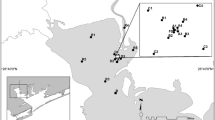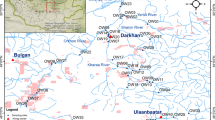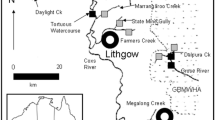Abstract
Estimating recovery times from pollution incident is an important issue of targeted biomonitoring programs. In the present study, the impact and recovery of macroinvertebrate communities from a cadmium wastewater discharge in the Longjiang River, Guangxi, China, in early January 2012 were studied based on 83 samples collected in five surveys within 20 months after the incident. The pollution affected seriously the local aquatic biota, and consequently, the invertebrate abundance and species richness were reduced considerably. Twelve months later, the taxonomic number of macroinvertebrates began to increase. However, sensitive taxa remained rare. Twenty months later, the taxon richness and abundance of macroinvertebrates increased significantly compared to those in the previous four time points. To explore the possible time-scale over which pre-disturbance conditions might occur, we chose four different typical metrics of taxa richness (total taxa number, cumulative taxa number, taxa number per samples, and the Shannon-Wiener diversity index) and extrapolated modeled recovery trajectories. Target values for the four metrics were set at average values for sites from the nearby Lijiang River, which were used as a reference. Assuming a continued linear trajectory, the recovery times were estimated to be 52, 39, 39, and 31 months, respectively, which was roughly 3–5 years. This is consistent with results from recovery times from other studies of acute pollution cases, but contrasted strongly to the much longer recovery times associated with chronic pollution from groundwater contamination and mine-tailing runoff.
Similar content being viewed by others
Data Availability Statement
All data used to support the findings of this study are available from the corresponding author upon request
References
Anderson C R. 2007. Effects of Mining on Benthic Macroinvertebrate Communities and Monitoring Strategy. U.S. Geological Survey, Reston, VA. p.851–872.
APHA. 1992. Standard Methods for the Examination of Water and Wastewater. 18th edn. American Public Health Association, Washington DC. 1025p.
Armitage P D, Bowes M J, Vincent H M. 2007. Long-term changes in macroinvertebrate communities of a heavy metal polluted stream: the river Nent (Cumbria, UK) after 28 years. River Research & Applications, 23(9): 997–1015.
Barbour M T, Graves C G, Plafkin J L, Wisseman R W, Bradley B P. 1992. Evaluation of EPA’s rapid bioassessment benthic metrics: metric redundancy and variability among reference stream sites. Environmental Toxicology and Chemistry, 11(4): 437–449.
Bellwood D R, Hughes T P, Folke C, Nyström M. 2004. Confronting the coral reef crisis. Nature, 429(6994): 827–833.
Brinkhurst R O, Jamieson B G M. 1971. Aquatic Oligochaeta of the World. Oliver and Boyd, Edinburgh. 860p.
Cairns J, Pratt J R. 1993. A history of biological monitoring using benthic macroinvertebrates. In: Rosenberg D M, Resh V H eds. Freshwater Biomonitoring and Benthic Macroinvertebrates. Chapman and Hall, New York. p.10–27.
Cao Y X. 2010. Benthic Macroinvertebrate Community Structure and Health Assessment of Li River, Guilin, Guangxi. Nanjing Agricultural University, Nanjing.
Carlisle D M, Clements W H. 1999. Sensitivity and variability of metrics used in biological assessments of running waters. Environmental Toxicology and Chemistry, 18(2): 285–291.
Chen K, Hughes R M, Xu S, Zhang J, Cai D S, Wang B X. 2014. Evaluating performance of macroinvertebrate-based adjusted and unadjusted multi-metric indices (MMI) using multi-season and multi-year samples. Ecological Indicators, 36: 142–151.
Chinese Environmental Protection Chief Bureau. 2002. Water and Wastewater Monitoring and Analysis Association, Standard Methods for the Examination of Water and Wastewater. 4th edn. Chinese Environmental Sciences Press, Beijing. 836p. (in Chinese)
Clements W H, Carlisle D M, Lazorchak J M, Johnson P C. 2000. Heavy metals structure benthic communities in Colorado mountain streams. Ecological Application, 10(2): 626–638.
Clements W H, Cherry D S, Cairns Jr J. 1988. Impact of heavy metals on insect communities in streams: a comparison of observational and experimental results. Canadian Journal of Fisheries and Aquatic Sciences, 45(11): 2 017–2 025.
Clements W H, Kiffney P M. 1995. The influence of elevation on benthic community responses to heavy metals in Rocky Mountain streams. Canadian Journal of Fisheries and Aquatic Sciences, 52(9): 1 966–1 977.
Clements W H, Vieira N K M, Church S E. 2010. Quantifying restoration success and recovery in a metal-polluted stream: a 17-year assessment of physicochemical and biological responses. Journal of Applied Ecology, 47(4): 899–910.
Clements W H. 1991. Community responses of stream organisms to heavy metals: a review of observational and experimental approaches. In: Newman M C, McIntosh A W eds. Metal Ecotoxicology: Concepts & Applications. Lewis Publishers, Boca Raton, FL. p.363–391.
Clements W H. 1994. Benthic invertebrate community responses to heavy metals in the Upper Arkansas River Basin, Colorado. Journal of the North American Benthological Society, 13(1): 30–44.
Editorial Committee of Encyclopedia of Rivers and Lakes in China. 2013. Encyclopedia of Rivers and Lakes in China, Section of Zhujiang River Basin. China Water & Power Press, Beijing. 525p. (in Chinese)
Feris K P, Ramsey P W, Frazar C, Rillig M, Moore J N, Gannon J E, Holben W E. 2004. Seasonal dynamics of shallow-hyporheic-zone microbial community structure along a heavy-metal contamination gradient. Applied and Environmental Microbiology, 70(4): 2 323–2 331.
Gray N F, Delaney E. 2008. Comparison of benthic macroinvertebrate indices for the assessment of the impact of acid mine drainage on an Irish river below an abandoned Cu-S mine. Environmental Pollution, 155(1): 31–40.
Gunderson L H. 2000. Ecological resilience—in theory and application. Annual Review of Ecology and Systematics, 31: 425–439.
Gunn J, Sarrazin-Delay C, Wesolek B, Stasko A, Szkokan-Emilson E. 2010. Delayed recovery of benthic macroinvertebrate communities in Junction Creek, Sudbury, Ontario, after the diversion of acid mine drainage. Human and Ecological Risk Assessment: An International Journal, 16(4): 901–912.
Hare L, Carignan R, Huerta-Diaz M A. 1994. A field study of metal toxicity and accumulation by benthic invertebrates; implications for the acid-volatile sulfide (AVS) model. Limnology and Oceanography, 39(7): 1 653–1 668.
Heckman C W. 1983. The recovery of the biotic community in a lotic freshwater habitat after extensive destruction by chlorine. Internationale Revue der Gesamten Hydrobiologie und Hydrographie, 68(2): 207–226.
Hynes H B N. 1960. The Biology of Polluted Water. Liverpool University Press, Liverpool, UK. 202p.
Jia Y Y, Wang L, Qu Z P, Wang C Y, Yang Z G. 2017. Effects on heavy metal accumulation in freshwater fishes: species, tissues, and sizes. Environmental Science and Pollution Research, 24(10): 9 379–9 386.
Kang I J, Nakamura A, Moroishi J, Ishibashi K, Fukuda S, Shimasaki Y, Oshima Y. 2009. Effects of heavy metal compounds on behavior of freshwater snail (Semisulcospira libertina). Science Bulletin of the Faculty of Agriculture, 64(2): 119–123.
Khan M I, Zahoo M, Khan A, Gulfam N, Khisroon M. 2019. Bioaccumulation of heavy metals and their genotoxic effect on freshwater mussel. Bulletin of Environmental Contamination and Toxicology, 102(1): 52–58.
Kiffney P M, Clements W H. 1996. Effects of metals on stream macroinvertebrate assemblages from different altitudes. Ecological Applications, 6(2): 472–481.
Liang Y L, Wang H Z. 1999. Zoobenthos. In: Liu J K ed. Advanced Hydrobiology. Science Press, Beijing. p.241–259. (in Chinese)
Liu Y Y, Zhang W Z, Wang Y X, Wang E Y. 1979. Economic Fauna of China — Freshwater Mollusca. Science Press, Beijing. 134p. (in Chinese)
Mciwem P S, Snook D, Muscutt A, Smith A. 2010. Effects of a diesel spill on freshwater macroinvertebrates in two urban watercourses, Wiltshire, UK. Water and Environment Journal, 24(4): 249–260.
Miao X Y, Hao Y P, Tang X, Xie Z Q, Liu L P, Luo S W, Huang Q B, Zou S Z, Zhang C L, Li J. 2020. Analysis and health risk assessment of toxic and essential elements of the wild fish caught by anglers in Liuzhou as a large industrial city of China. Chemosphere, 243: 125337.
Millennium Ecosystem Assessment. 2005. Ecosystems and Human Well-Being: Synthesis. Island Press, Washington DC.
Morse J C, Yang L F, Tian L X. 1994. Aquatic Insects of China Useful for Monitoring Water Quality. Hohai University Press, Nanjing. 570p.
Niemi G J, Devore P, Detenbeck N, Taylor D, Lima A, Pastor J, Yount J D, Naiman R J. 1990. Overview of case studies on recovery of aquatic systems from disturbance. Environmental Management, 14(5): 571–587.
Paine R T, Tegner M J, Johnson E A. 1998. Compounded perturbations yield ecological surprises. Ecosystems, 1(6): 535–545.
Qu X D, Wu N C, Tang T, Cai Q H, Park Y S. 2010. Effects of heavy metals on benthic macroinvertebrate communities in high mountain streams. Annales de Limnologie-International Journal of Limnology, 46(4): 291–302.
Rapport D J, Regier H A, Hutchinson T C. 1985. Ecosystem behavior under stress. The American Naturalist, 125(5): 617–640.
Rosenberg D M, Resh V H. 1993. Introduction to freshwater biomonitoring and benthic macroinvertebrates. In: Rosenberg D M, Resh V H eds. Freshwater Biomonitoring and Benthic Macroinvertebrates. Chapman & Hall, New York. p.1–9.
Schmidt T S, Clements W H, Mitchell K A, Church S E, Wanty R B, Fey D L, Verplanck P L, Juan C A S. 2010. Development of a new toxic-unit model for the bioassessment of metals in streams. Environmental Toxicology and Chemistry, 29(11): 2 432–2 442.
Smith D A. 1987. Mining in America. University Press of Kansas, Lawrence, KS.
Sperber C. 1948. A taxonomical study of the Naididae. Zoologiska Bidrag Från Uppsala, 28: 1–296.
Verdonschot P F M, Spears B M, Feld C K, Brucet S, Keizer-Vlek H, Borja A, Elliott M, Kernan M, Johnson R K. 2013. A comparative review of recovery processes in rivers, lakes, estuarine and coastal waters. Hydrobiologia, 704(1): 453–474.
Wallace J B. 1990. Recovery of lotic macroinvertebrate communities from disturbance. Environmental Management, 14(5): 605–620.
Wang H Z. 2002. Studies on Taxonomy, Distribution and Ecology of Microdrile Oligochaetes of China, with Descriptions of Two New Species from the Vicinity of the Great Wall Station of China, Antarctica. Higher Education Press, Beijing. 228p. (in Chinese)
Winner R W, Boesel M W, Farrell M P. 1980. Insect community structure as an index of heavy-metal pollution in lotic ecosystems. Canadian Journal of Fisheries and Aquatic Sciences, 37(4): 647–655.
Zhang X J, Chen C, Mi Z L, Wang C K. 2013. Emergent cadmium removal technology for drinking water and measures for environmental accident in Guangxi Longjianghe River. Water & Wastewater Engineering, 39(1): 24–32. (in Chinese with English abstract)
Acknowledgment
We are indebted Dr. Ke CUI of South China Agriculture University, and Mr. Siyang LI and Ms. Ling’ai YAO of South China Institute of Environmental Science, Ministry of Environmental Protection for assistance in the field sampling.
Author information
Authors and Affiliations
Corresponding author
Additional information
Supported by the Environmental Protection Department of China (No. PM-ZX019-201207-018) and the National Science Foundation of China (No. 31100407)
Electronic supplementary material
Rights and permissions
About this article
Cite this article
Cui, Y., Wang, B., Zhao, Y. et al. Recovery time of macroinvertebrate community from Cd pollution in Longjiang River, Guangxi, China. J. Ocean. Limnol. 40, 183–194 (2022). https://doi.org/10.1007/s00343-021-0341-5
Received:
Accepted:
Published:
Issue Date:
DOI: https://doi.org/10.1007/s00343-021-0341-5




